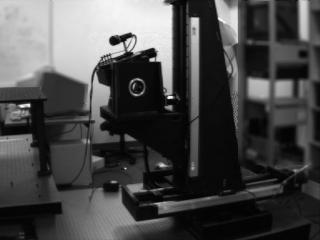Experiments With a Real-Time Structure-From-Motion System.
Fourth International Symposium on Experimental Robotics, ISER '95, June 1995, pp. 123-128.
Summary
... Next Page ...
|
Summaries
A Resampling Method for Computer Vision| A resampling procedure based on Efron's bootstrap method is proposed for the robust estimation of parameters from redundant data. The procedure handles a substantial fraction of outliers, has linear complexity even for superlinear estimation problems, can be applied to any parameter estimation algorithm without modification, and is easily parallelized. The problem of estimating camera motion from instantaneous image velocities is used to illustrate the method. Simulations and results show robust and accurate results. |
Computing Camera Heading
|
The visual angle changes of two feature points from the camera center
satisfies the disparity formula as camera moves
|
|
How to Rotate a Camera
| A procedure is proposed that, given any rotating device to support a camera, places the camera's center of projection to within a tenth of a millimeter from the axis of the rotating device, even with wide angle lenses with severe distortion. Results are experimentally validated by checking that all the camera projection centers as computed through an off-the-shelf calibration method are at the same point in the world, and that the camera rotations computed by the same calibration method are close to the true values measured with a mechanical, high accuracy positioning jig. Experimental data and Matlab code are made available on the worldwide web. | 
|
Is Structure-From-Motion Worth Pursuing?
| There will always be noise in the input. How does this affect the computation results of (SFM) shape from motion? This paper simulates this effect. Conclusions are drawn by looking into the singular value structure of the Jacobian matrices at the solution. |
Experiments With a Real-Time Structure-From-Motion System.
| A real-time implementation of structure-from-motion was implemented. It provided algorithms of real-time tracking and computation of shape and motion in the 2D world. A strategy of data accumulation is also presented. |